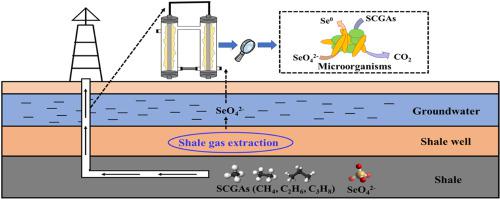Water Research ( IF 12.8 ) Pub Date : 2020-06-13 , DOI: 10.1016/j.watres.2020.116008 Chun-Yu Lai 1 , Yarong Song 1 , Mengxiong Wu 1 , Xuanyu Lu 1 , Yulu Wang 1 , Zhiguo Yuan 1 , Jianhua Guo 1

|
Selenate (Se(VI)) contamination in groundwater is one of major concerns for human health, in particular in shale gas extraction sites. Microbial selenate reduction coupled to methane (CH4) oxidation has been demonstrated very recently. Little is known whether ethane (C2H6) and butane (C3H8) are able to drive selenate reduction, although they are also important components in shale gas. In this study, we demonstrated Se(VI) bio-reduction could be achieved using C2H6 and C3H8 as electron donors and carbon sources. Scanning electron microscopy coupled to energy dispersive X-ray spectroscopy (SEM-EDX) confirmed elemental Se (Se0) was the major final product formed from Se(VI) bio-reduction. Polyhydroxyalkanoates (PHAs) were generated in the biofilms as the internal electron-storage materials, which were consumed for sustaining Se(VI) bio-reduction in absence of C2H6 and C3H8. Microbial community analysis showed that two genera capable of oxidizing gaseous alkanes dominated in the biofilms, including Mycobacterium (in both C2H6 and C3H8-fed biofilms) and Rhodococcus (in C3H8-fed biofilm). In addition, several potential Se(VI) reducers (e.g., Variovorax) were detected in the biofilms. Investigation of Communities by Reconstruction of Unobserved States analysis supported that predictive genes associated with alkanes oxidation, denitrification and PHAs cycle were enriched in the biofilms. These findings offer insights into the process of selenate reduction driven by C2H6 and C3H8, which ultimately may help to develop a solution to use shale gas for groundwater remediation, especially near shale gas exploitation sites.
中文翻译:

使用乙烷和丙烷作为电子给体的膜生物膜反应器中微生物硒酸盐的还原
地下水中的硒酸盐(Se(VI))污染是人类健康的主要问题之一,特别是在页岩气开采场所。最近已经证明微生物硒酸盐还原与甲烷(CH 4)氧化有关。尽管乙烷(C 2 H 6)和丁烷(C 3 H 8)也是页岩气中的重要成分,但它们是否能够促进硒酸盐的还原还鲜为人知。在这项研究中,我们证明了使用C 2 H 6和C 3 H 8可以实现Se(VI)的生物还原。作为电子供体和碳源。扫描电子显微镜结合能量色散X射线光谱法(SEM-EDX)证实元素Se(Se 0)是从Se(VI)生物还原形成的主要最终产物。聚羟基链烷酸酯(PHAs)在生物膜中作为内部电子存储材料生成,在没有C 2 H 6和C 3 H 8的情况下被消耗以维持Se(VI)的生物还原。微生物群落分析表明,能够氧化生物膜中支配的气态烷烃的两个属,包括分枝杆菌(在C 2 H 6和C 3 H 8中)喂食的生物膜)和红球菌(在C 3 H 8喂食的生物膜中)。另外,在生物膜中检测到了几种潜在的Se(VI)还原剂(例如Variovorax)。通过重建未观察到的国家进行的社区调查分析支持与烷烃氧化,反硝化和PHA循环相关的预测基因在生物膜中丰富。这些发现提供了对由C 2 H 6和C 3 H 8驱动的硒酸盐还原过程的见解,这最终可能有助于开发一种解决方案,以利用页岩气修复地下水,特别是在页岩气开采点附近。


























 京公网安备 11010802027423号
京公网安备 11010802027423号